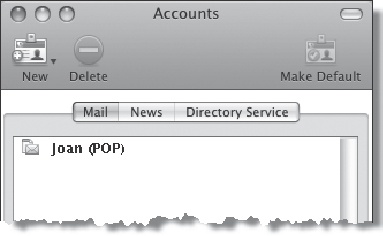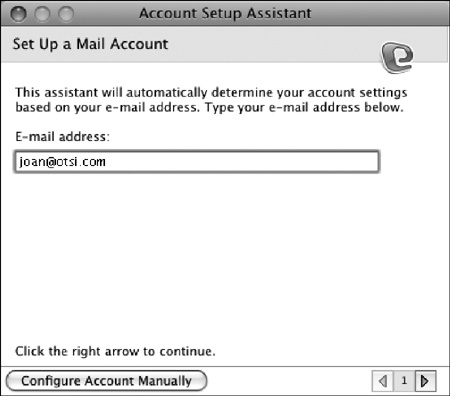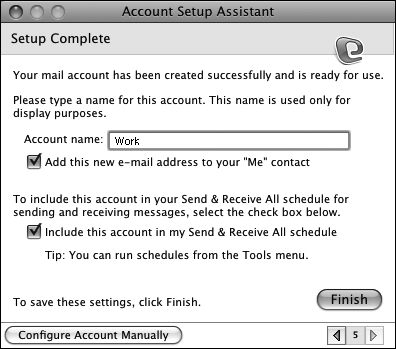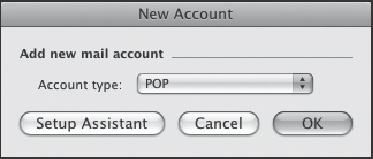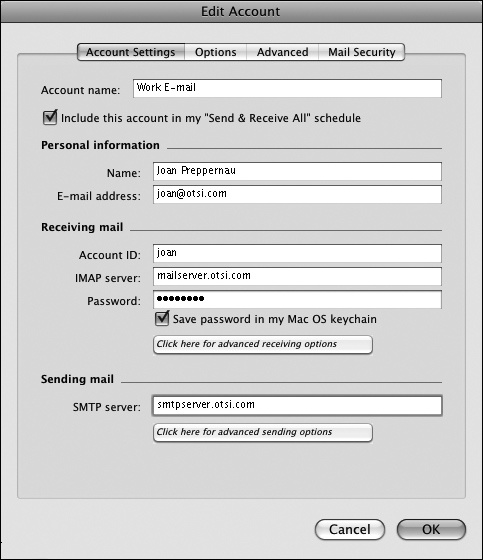You can connect to multiple accounts, and to multiple types of accounts, from Entourage 2008. If you’re running the standard or Special Media Edition of Office 2008, you can connect to an IMAP, a POP, a Windows Live Hotmail, or a Microsoft Exchange Server account.
You can configure Entourage to connect to an e-mail account by completing an interview process in the Account Setup Assistant or, if you’re comfortable with the process of configuring an e-mail program, you can perform the configuration manually. The automatic setup functionality provided by the Account Setup Assistant is very convenient. In most cases, the only information you need is your e-mail address and password.
Before connecting from Entourage to an e-mail account, you will need to know the e-mail address, the account ID, and the account password. In addition:
For IMAP and Exchange accounts, you’ll need the incoming server name.
For IMAP and POP accounts that use a separate SMTP server to process outgoing mail, you‘ll need to know the outgoing server name. If the outgoing server requires different credentials, you’ll need the account ID and password for that server.
To configure a connection from Entourage to an e-mail account, by using the Account Setup Assistant:
On the Tools menu, click Accounts.
The Accounts dialog box opens.
In the Accounts dialog box, click the New button, and then click Mail (or, to connect to an Exchange account, click Exchange).
The Account Setup Assistant starts, and displays the Set Up A Mail Account page.
In the E-mail address box, enter the e-mail account you want to connect to.
Click the Next button to submit the account for automatic configuration.
If Entourage successfully connects to the account without additional information, the Automatic Configuration Succeeded page appears.
If Entourage requires additional information to connect to the account, the Automatic Configuration Failed page appears.
If the automatic configuration was successful, click the Next button to display the Verify and Complete Settings page. Verify your name and e-mail address, and enter the password required to access the account.
Selecting the Save Password check box saves the password for automatic login.
If the automatic configuration was not successful, click the Next button to display a more complete version of the Verify and Complete Settings page. Enter the information required to access the account.
Click the Next button to display the Optional: Verify Settings page, and then click the Verify My Settings button.
Entourage tests the connection to the account and reports the results.
If the verification fails, click the Back button to return to the Verify and Complete Settings page. The settings that failed verification are now indicated in red. Correct the information in these fields, and then click the Next button to return to the Optional: Verify Settings page.
After the verification succeeds, click the Next button to display the Setup Complete page. Enter the name by which you want to identify the account. If you want the account to appear in your Entourage contact record, and to be updated at regular intervals with other accounts, leave the check boxes selected; otherwise, clear the ones you don’t want to apply. Then click Finish.
Entourage adds the newly configured account to the Accounts dialog box, creates a folder for the account in the Folder list, and creates the appropriate subfolders.
Tip
Each type of e-mail account other than POP has a specific base set of subfolders. (A POP account uses the folder structure under the On My Computer heading.) A Windows Live Hotmail account has Inbox, Sent Items, Deleted Items, and Junk E-Mail folders. An IMAP account has a Drafts folder in addition to the four basic folders. An Exchange account also has Calendar, Contacts, Journal, Notes, Outbox, RSS Feeds, Sync Issues, and Tasks folders.
To manually configure a connection from Entourage to an e-mail account:
On the Tools menu, click Accounts, and then click the New button (not its arrow).
The New Account dialog box opens.
In the Account type list, click the type of account you want to connect to (POP, IMAP, Exchange, or Windows Live Hotmail). Then click OK.
Enter the requested information in the dialog box.
If your incoming server requires special information, click the Click here for advanced receiving options button in the Receiving mail section to display a box of options specific to the incoming server. Select the check boxes that are pertinent to your account, and then close the box.
If your outgoing server requires special information, click the Click here for advanced sending options button in the Sending mail section to display a box of options specific to the outgoing server. Select the check boxes that are pertinent to your account, provide any additional information that is requested, and then close the box.
In the Edit Account dialog box, click OK.
After you connect to an account, a corresponding account group appears in the Folder list. If the account is an Exchange, IMAP, or Windows Live Hotmail account, the account folders appear under the account group.
You can collapse or expand an account header by clicking the arrow to the left of the account name. Clicking the header itself displays the base content of the account in the content pane. For a POP account, the base content consists of messages. For other types of accounts, the base content is the folder structure—the same structure that appears when you expand the account group header.

